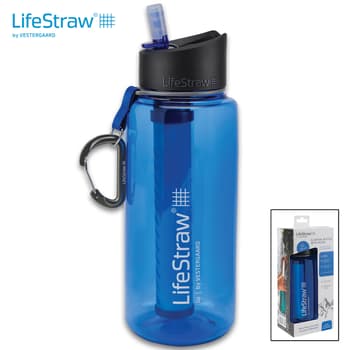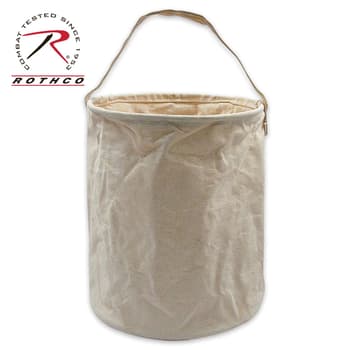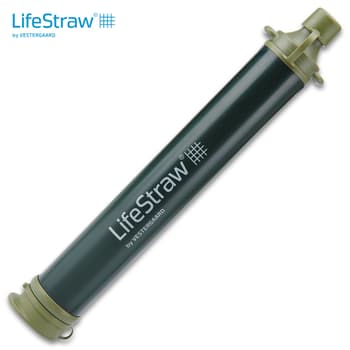Finding And Filtering Water

By Adelia Ladson
When you’re out in the wilderness, either by choice or chance, the one thing that will take you out without question is dehydration. You may get snake-bit, or you may fall and break your leg, but you will die of dehydration if you don’t get water. No ifs, ands or buts. It will happen in about three days: four if you’re lucky. So, the clock is ticking, folks. Let’s find some water!
Water can be found or collected and then filtered or chemically purified or boiled to make it safe for consumption. As always, first take stock of what you have. What are your assets? I, personally, don’t think you should go anywhere without a good knife, be it a folding pocket or fixed blade. Also, do you have a container, even if it’s just a plastic water bottle or soda bottle? Do you have a piece of plastic, like a garbage bag or grocery bag? Do you have string or something you can use to secure something with?
Collecting Water
Let’s start with, what I consider, the more difficult of the two choices that you have – collecting water. Of course, if it’s raining, you’re in great shape as far as water collection goes. Otherwise, there are other ways like tapping a tree, getting it from other pulpy vegetation, collecting dew in the early morning and using the transpiration from foliage. If snow and ice are available, you are pretty much set just like with rain. Just make sure that you boil it first because eating it frozen will lower your body temperature and actually increase your risk of dehydration.
Depending on where you are and what trees are in your vicinity, tapping a tree may not be an option. Also, you can only really be successful from about January through March when the sap is running. If you are able to use this method, you will get water to drink that is almost pure. You really won’t need to worry about filtering or purifying it. Some trees that can be used to collect water from are birch (especially, the River Birch), sycamore, black walnut and ironwood. The lower the sugar content the better as far as I’m concerned because sugar makes me thirsty. Remember syrup is made from the sap of some of these trees. The River Birch has one of the lowest sugar contents and is touted for its overall health benefits. Some folks actually harvest it just to drink as a tonic.
Getting water from vegetation also depends on where you are and what plants you have access to. In jungle environments, you can get water from things like bamboo, vines with rough bark and coconut palms. Just a note about the desert. You can get water from cactus fruit, but they won’t sustain you but if you decide to drink what you find in a barrel cactus like you see people do on television, be prepared to be poisoned. You can also get water from plants that have big roots or fleshy leaves. A note of caution, though. If the liquid from the vegetation is sticky, milky looking or bitter tasting, don’t drink it. Another method is by collecting dew before the sun comes up and burns it off. You can do this by using your shirt to soak up the dew and then wring it into a container or directly into your mouth. Of course, this works the best when you have a field of tall grass that you can basically wade through with your shirt tied around your leg to collect the dew and it's even better if you have a shirt for each leg.
I think my favorite is the transpiration method, which basically means you’re sweating water out of foliage. We perspire and plants transpire. With this, you will need a plastic bag or some good sized piece of plastic and something to tie it to the branch of foliage you’re using. Once again, in my opinion, on items that you shouldn’t go anywhere without … Paracord. That’s some pretty handy stuff right there. Now this method can seem painstakingly slow and the yield will be small but if you have no other choice...
Finding Water
Bar it’s raining and water is literally falling out of the sky, collecting water is a lot more time-consuming and takes more preparation than finding water. Probably about 75% of the time, you’re in an area that will have a source of water for you whether it’s just under the surface or some kind of body of water. Just because you don’t see it, doesn’t mean it’s not out there.
Some of the signs you can look for are lush green vegetation, swarming insects and damp patches of earth. Also, pay attention to the flight of birds in the morning or evening because they will know where there’s water. Pay attention to where different animal tracks cross each other because you could find a common watering hole for the local wildlife. Also, don’t forget to stop moving, get still and use your ears to listen for the sound of water. Runoff water will always collect in low-lying areas in the form of pools, ponds and creeks. So, always, head downhill when you're looking for water.
If the ground is muddy, dig down into it about a foot down and a foot in diameter and let the water settle at the bottom of the hole. You can also look for water under the surface in the desert. Just look for trees or green vegetation because they will need a source of water to survive. If you’re in a rocky terrain, look for water to pool in the crevices of the rocks. If, say, you’re shipwrecked, you can "find water" by digging a beach well about 100 feet from the waterline or behind the first sand dune. Dig down about five feet, put rocks in the bottom to settle the sand line the sides with wood. Give it a taste when it fills up and see if it’s too salty. If so, then move further back away from the waterline.
Purifying Water
Once you’ve found your source of water, unless you want to get something nasty that will make you really sick or kill you, purify what you drink as best as you can. Even, if the water looks clear, that doesn’t mean microscopic creepy crawlies aren’t swimming around in it. Rain water is usually pretty safe but my feeling is "an ounce of prevention….".
The best non-chemical way of purifying your water is by simply boiling it for a good ten minutes at a good rolling boil. Then, you filter out any sediment by straining it through your shirt or any piece of cloth on-hand. Now, the obvious to this is that you need to build a fire and you should always have a way to start a fire with you.
Of course, if you do happen to have water purifying tablets or pouches of powder on you, then, just follow the direction on the packaging. You know, these really aren’t a bad investment to have in your camping gear, your home or even your vehicle. They don’t take up that much space. You might try the Rothco Water Purification Powder. Just a note about being at home and needing potable water. You can always use bleach to purify it by using eight drops of bleach per gallon of water.
If you are really just completely out of options but are using a clear plastic water or soda bottle as your water container, you can always use the sun. Leave the bottle out on its side and let the sun cook the water for about six hours if you have full sunlight or it’s only partly cloudy. If the sky is half-filled with clouds or more then, unfortunately, this method could take two days. Make sure, though, that you filter the water first through a piece of cloth to remove any sediment. You need the water as clear as you can get it for maximum UV penetration.
Now me, personally, I like the idea of being prepared for the worst ahead of time. There are lots of great personal water filtration systems out there that don’t’ take up much space in your gear or vehicle for that matter. One of my favorites is the Mini Water Filter Straw. With this convenient little piece of equipment, you can actually just stick it into a creek or pond and drink to your heart’s content. Just as easily as drinking a soda with a straw. It can also be threaded onto a standard water bottle or attached to the collapsible water bag that’s included with it. Another personal filter that I like is the Trailblazer Pump Water Filter, which uses a pump system.
An absolute must-have when you have your family to take care of, is the LifeStraw Flex With Gravity Bag. It’s a versatile water filter system that can be used four ways including as a personal straw filter; with the included gravity bag; as an in-line filter with most hydration packs; or attached to most disposable water bottles. When using with the gravity bag, you can quickly filter one gallon of water in less than ten minutes. The entire system is compact and ultralight and, in a survival or bug-out situation, is one of the most important things you should have or take with you.



